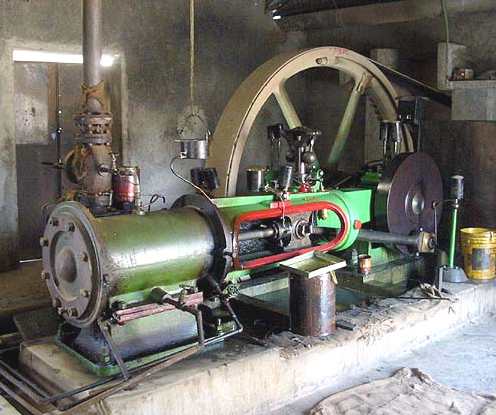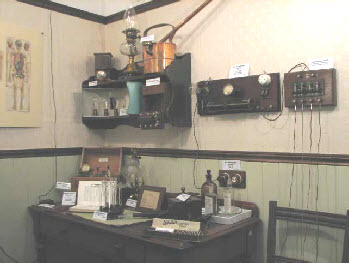|
AMBERLEY WORKING MUSEUM
|
|||
|
HOME | BIOLOGY | FILMS | GEOGRAPHY | HISTORY | INDEX | INVESTORS | MUSIC | NEWS | SOLAR BOATS | SPORT |
|||
|
Amberley Working Museum is a 36 acre open-air museum dedicated to the industrial heritage of the south-east. Staffed largely by volunteers, the Museum contains a wide range of exhibits, ranging from transport-based collections, such as the Southdown bus collection & the village garage, to industry-based collections, such as the Print Workshop & Wheelwrights. I visited the Museum in 2004 and was delighted to find several rare generators and other interesting exhibits among them a welding machine used to found JCB and some early electric vehicles. I hope to have time to include some of my photographs on this page soon. NK
The Museum is also home to a number of resident craftspeople, who work to traditional methods. Many people like to take an introductory tour of Amberley, which can be accessed from their Online Exhibition section or by clicking here.
A Robey stationary steam engine at work in India
An electrifying exhibition!
The garden area in front of the building displays outdoor sub-station equipment including Insulators, Transformers & Switchgear, plus an unusual pole-mounted Lightning Arrester and two decorative cast-iron Sub-Station Kiosks.
Inside the Front Hall, the centrepiece is a Belliss & Morcom high-speed steam-driven generating set, from the old Wills Tobacco Works in Bristol. To the left and right are 2 large open-type distribution switchboards, once common in factories & institutions. Beyond is a Rotary Balancer from Folkestone Power Station, used in the days of DC (direct current) supply. Other exhibits in this room include plugs, sockets & switches, electricity meters, cables, enclosed-type switchgear, electric motors & electric vehicles old & new. There is also a working display of the Asea substation remote control system used by Southern Railway in their electrification schemes from 1930 onwards.
Above the opening into the rear hall is a large neon sign, originally from "Electric House", Croydon, depicting the word "Electricity" in the style used by Michael Faraday in his experimental notes. Behind the window is a 250,000 volt Impulse Generator, as used in industry for testing high-voltage components for the electricity supply system. This exhibit is demonstrated periodically and the "artificial lightning" produced is an impressive and noisy spectacle! There is also a Tesla Coil illustrating the spectacular and continuous discharges produced with high-frequency electricity.
Along the left side of the rear hall is a "hands-on" Introductory Gallery named after Bob Gordon, the Milne's first Curator, and along the right side are the Domestic Displays - grouped in decades to show how the number and sophistication of appliances have increased over the years.
At the back are shop-front displays illustrating more period domestic appliances, medical and laboratory test equipment. The upstairs lecture area is used for special talks and demonstrations on electricity, available by prior arrangement to schools and other booked parties.
Volunteers from the EDF Energy Electricity Hall have their own website, www.milnemuseum.org.uk and there are a number of other interesting links below.
Amberley Museum early electrical switches and controls
HISTORY
c.1830 - 1968
The site was developed in the early Victorian era to quarry chalk, which was converted in kilns to produce lime, a key building material for mortar and cement. The quarries are known to have developed prior to 1840, making good use of their proximity to the River Arun and Amberley Station. The building now known as Humphrey's Barn was built around 10 years earlier, when the site was still a farm.
The Quarry site lay stagnant for several years after the business closed.
1968
to the present
The Museum is open from mid March to late October each year
Gift Aid provides the means for Amberley to gain more value from your visit
Admission Prices
Adult - £8.70 Over 60 - £7.70 Students - £7.70 Children (5-16 yrs) - £5.50 Under Fives - FREE Family Ticket (2 adults & up to 3 children) - £25.00
Amberley Working Museum, Amberley, West Sussex, BN18 9LT
Telephone: 01798 831370 . Email: office@amberleymuseum.co.uk
http://www.amberleymuseum.co.uk/ http://www.milnemuseum.org.uk/links.html AMBERLEY
WORKING MUSEUM: Our hosting Museum
Herstmonceux Electricity Generating Works Circa. 1900 - 1936 Links:
Introduction | Instructions | ISBN | Batteries | Boiler Room | Floor Plan | Ron Saunders | Industrial Revolution | Lime Park | Machinery | Map Power House | Argus 1999 | Public Supply | Roof Construction | Rural Supply Sussex Express 1913 | Conclusion
Archaeology South East | East Sussex CC | English Heritage | SIAS | Sx Exp 1999
Memories of Herstmonceux by Margaret Pollard
GENERAL HISTORY LINKS
MARITIME HISTORY
Healthier alternative tastes for adventure capitalists
Solar Red | Solar Crush + | Solar Cola | Solar Citrus + | Solar +
|
|||
|
This
website
is Copyright © 1999 & 2007 NJK. The bird |
|||
|
AUTOMOTIVE | BLUEBIRD | ELECTRIC CARS | ELECTRIC CYCLES | SOLAR CARS |


